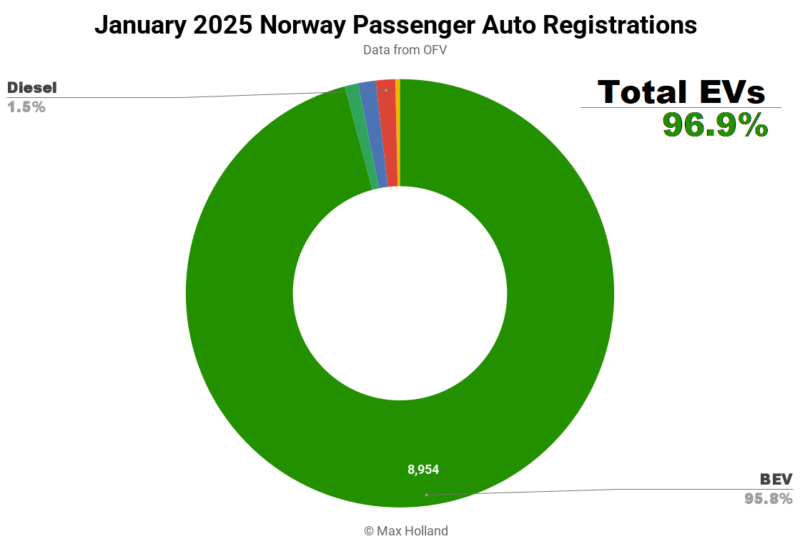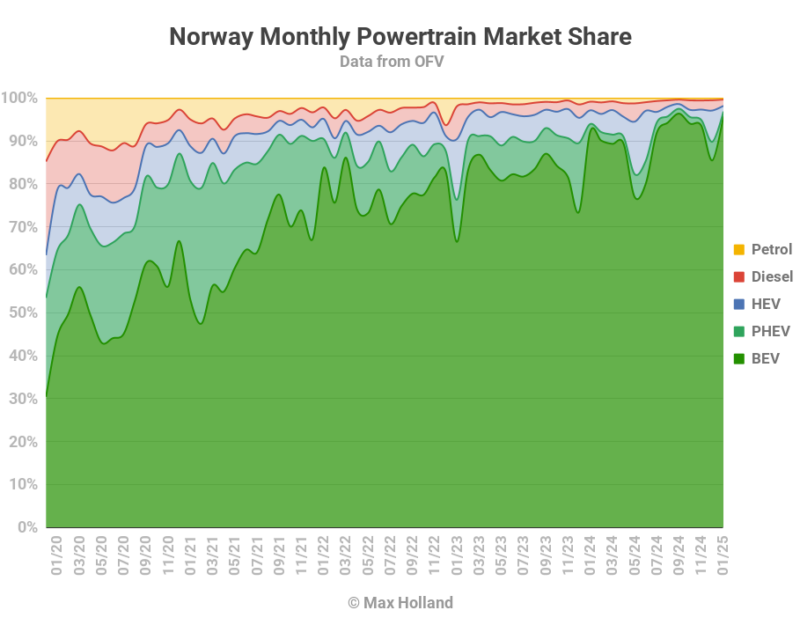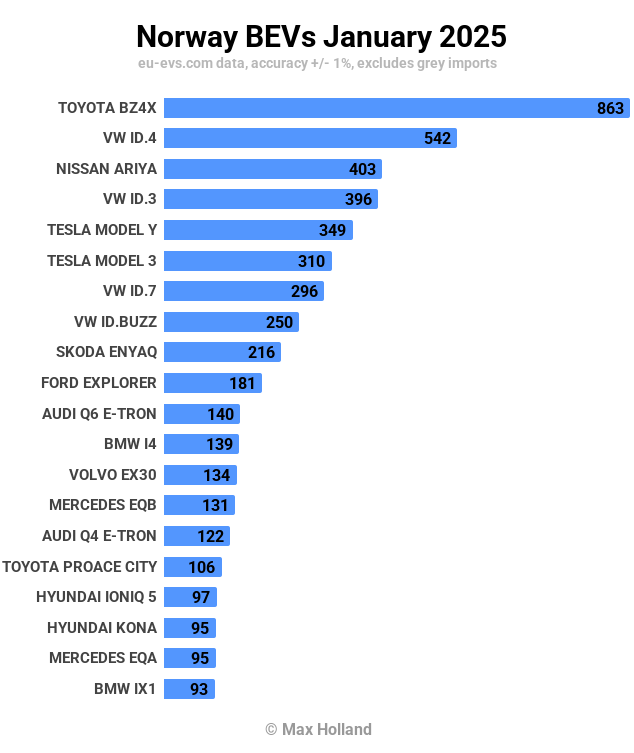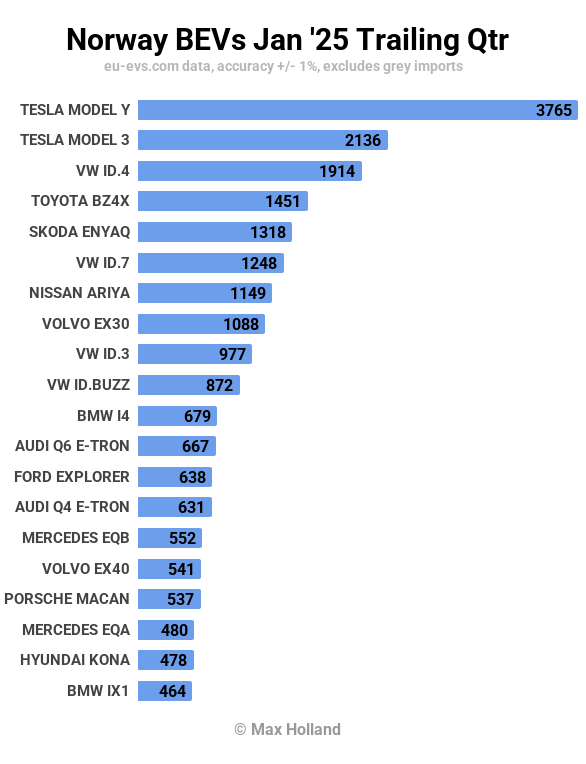
Sign up for daily news updates from CleanTechnica on email. Or follow us on Google News!
January saw plugin EVs take 96.9% share in Norway, up from 93.9% year on year. BEVs alone took almost 96% of the market. Overall auto volume was strongly up on seasonal norms, at 9,343 units, up 82% YoY. The Toyota BZ4X was the best-seller.

January’s auto sales saw combined EVs take 96.9% share in Norway, comprising 95.8% full electrics (BEVs), and 1.0% plugin hybrids (PHEVs). These compare with YoY figures of 93.9% combined, with 92.1% BEV, and 1.8% PHEV.
January is habitually the lowest-volume month of the year for the overall auto market, but this year saw an unusually high volume. This is perhaps because consumers are feeling more optimistic that the economy has recently been somewhat positive and stable following the mid-2023 downturn, and thus feel it is a “safe” time to stretch for a new car (this perspective is also shared by Norway’s OFV).
There were no substantial changes (as far as I can find, comment if you know otherwise) to the taxation rates for different vehicle powertrains in January 2025, so the month did not see any step-changes in the balance of powertrains. What January did see was the continuing inexorable climb of BEVs.
The OFV reports that only two auto models in the top 50 overall autos were not BEVs (and the first of them appearing at 34th rank). OFV doesn’t give the details of which models these were, but the usual candidates are the Toyota Yaris, Corolla, or RAV4 hybrid. There may be a Skoda diesel in the mix also.
Regardless, no other powertrain is above 1.5% of the market now, with diesels in that position. HEVs come next at 1.3%, followed by PHEVs at 1.0% and petrol-only at just 0.35% (and 33 units).

Best-Selling Models
The Toyota BZ4X was the best-selling auto in January, with 863 units, ahead of the Volkswagen ID.4 (542 units), and Nissan Ariya (403).

The Toyota BZ4X’s lead appears to be due to a batch shipment arriving in January, boosting its total, and representing its personal best performance in Norway. Its average monthly volume over the past 12 months has been slightly over 500 units – decent, but only enough to put it in 5th spot over this longer period. Let’s see if Toyota supplies a sustained higher volume this year.
The other top 20 models are familiar faces, and it’s worth noting that the new Audi Q6 e-tron seems to be stabilizing near 10th position, an impressive result given its high price point.
In terms of new models arriving in Norway for the first time, the Hyundai Inster appeared in January, with just 4 initial units. This is a subcompact “SUV” measuring 3,830 mm in length, with MSRP starting from 231,000 NOK (19,900€). For more details on the Hyundai Inster, see Jose’s recent summary. Offering a well-thought-out package, at good value, I’d expect the Inster to climb close to the top 20, although — at almost half a meter shorter than the Volvo EX 30 – it may be a little too small for most Norwegian car buyers.
As for recently arriving models, the Opel Grandland followed its 3-unit December debut with a decent 37 units in January. The Audi S6 e-tron climbed to 17 units, up from just single units over the previous two months. The new Dongfang Nammi Box (from 17,200€) got back to a decent 20 units after having taken an early pause at just 6 units in December (from its November 23-unit debut). Even the MG Cyberster convertible climbed again in January, to 8 units during the Norwegian winter. Perhaps the Cyberster can get to 20 or 30 monthly units in the summer? Let’s wait and see.
Here’s the 3-month chart:

Despite a moderate January, the Tesla Model Y still has a strong lead, built on big November and December volumes. Depending on how quickly the refreshed Model Y can be pushed out (starting in March), it may or may not lead Q1’s rankings. Given the technical refresh, however, coming on top of how overwhelmingly dominant the Model Y was in 2024, it would be unwise to bet against it leading again in 2025. With more and more good BEVs on offer, the Model Y’s lead may shrink, but is unlikely to be overturned.
The Tesla Model 3 took second place, and the Volkswagen ID.4 came in third. Further back, the only notable trends in the table are a couple of recent climbs. The most significant of these was the Ford Explorer, which had only just arrived in the previous period (August to October), though had already achieved a respectable 20th place. Now it has climbed further, to 10th, a great result for Ford. The other newish model still climbing is the Audi Q6 e-tron, just behind the Ford, in 11th spot, also a great result.
It will be interesting to see whether the Opel Grandland, or the Hyundai Inster, can step into the top 20 in the months ahead – what do you think? Let us know in the comments.
Outlook
As noted earlier, the year-on-year growth in the Norwegian auto market seems to reflect the recent broader upturn in the country’s economy, following the downturn in 2023. The latest confirmed macro data remains that from Q3 2024, which saw GDP up a healthy 3.5% YoY. The Q4 figure is forecast at 3.2% YoY growth, though the actual figure will arrive next week. Inflation now stands at 2.2%, and interest rates remain at 4.1%, unchanged in over a year, but expected to fall soon. Manufacturing PMI was 51.2 points in January, up from 50.4 points in December.
Although Norway is already at the culmination of the EV transition, the remaining few % share will be helped by the arrival of more affordable BEVs stemming from the Europe-wide emissions tightening rules in 2025. As discussed in recent reports, other underserved niches (like medium-sized pickup trucks) will also see BEV options arriving in 2025, also helping the BEV share fill out the remaining few % of the market.
What are your thoughts on Norway’s auto market? What models might rise or fall in popularity in 2025? Please jump into the comments below and join in the conversation.
Chip in a few dollars a month to help support independent cleantech coverage that helps to accelerate the cleantech revolution!
Have a tip for CleanTechnica? Want to advertise? Want to suggest a guest for our CleanTech Talk podcast? Contact us here.
Sign up for our daily newsletter for 15 new cleantech stories a day. Or sign up for our weekly one if daily is too frequent.
CleanTechnica uses affiliate links. See our policy here.
CleanTechnica’s Comment Policy


